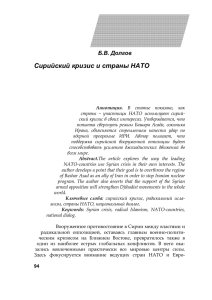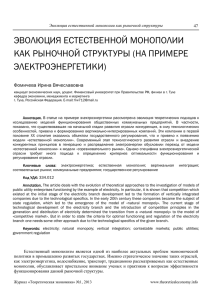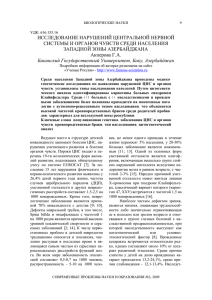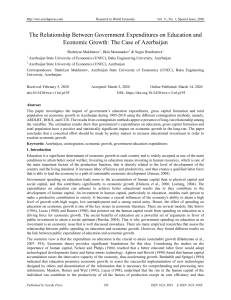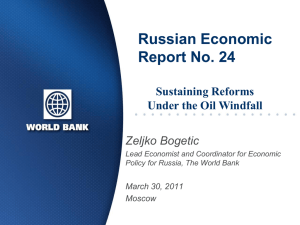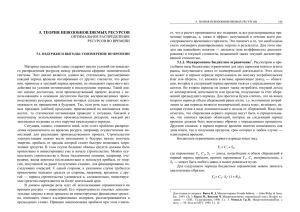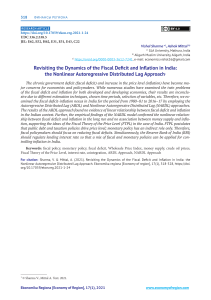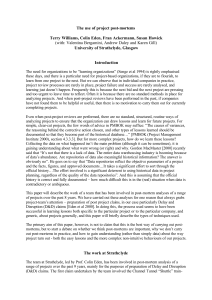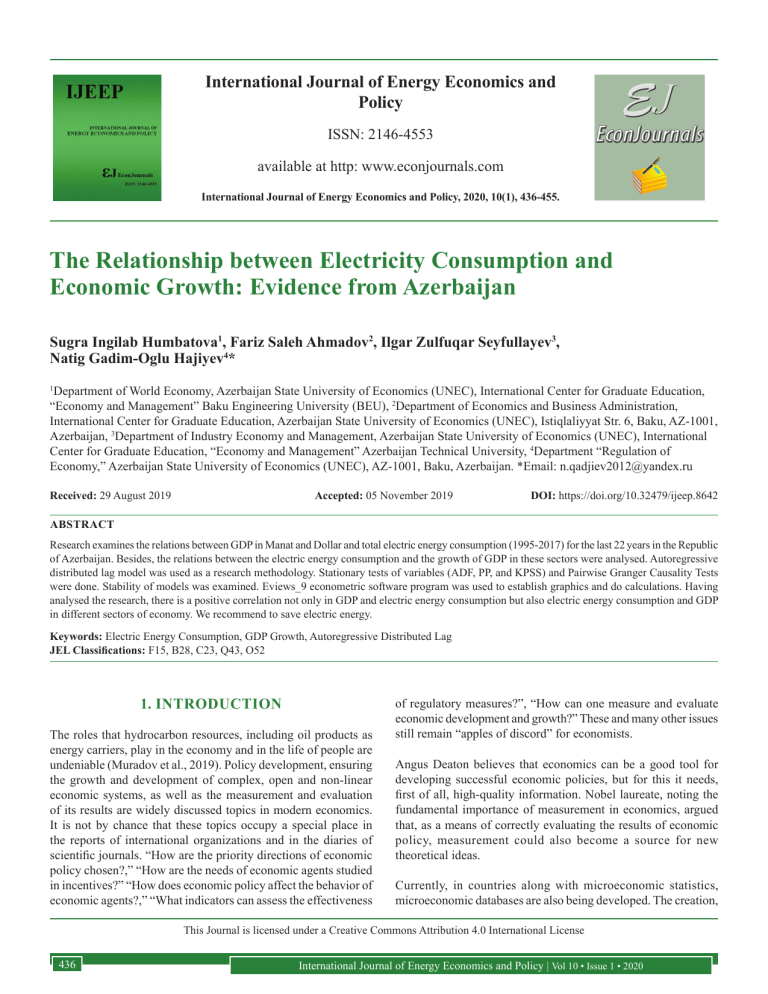
International Journal of Energy Economics and Policy ISSN: 2146-4553 available at http: www.econjournals.com International Journal of Energy Economics and Policy, 2020, 10(1), 436-455. The Relationship between Electricity Consumption and Economic Growth: Evidence from Azerbaijan Sugra Ingilab Humbatova1, Fariz Saleh Ahmadov2, Ilgar Zulfuqar Seyfullayev3, Natig Gadim-Oglu Hajiyev4* Department of World Economy, Azerbaijan State University of Economics (UNEC), International Center for Graduate Education, “Economy and Management” Baku Engineering University (BEU), 2Department of Economics and Business Administration, International Center for Graduate Education, Azerbaijan State University of Economics (UNEC), Istiqlaliyyat Str. 6, Baku, AZ-1001, Azerbaijan, 3Department of Industry Economy and Management, Azerbaijan State University of Economics (UNEC), International Center for Graduate Education, “Economy and Management” Azerbaijan Technical University, 4Department “Regulation of Economy,” Azerbaijan State University of Economics (UNEC), AZ-1001, Baku, Azerbaijan. *Email: n.qadjiev2012@yandex.ru 1 Received: 29 August 2019 Accepted: 05 November 2019 DOI: https://doi.org/10.32479/ijeep.8642 ABSTRACT Research examines the relations between GDP in Manat and Dollar and total electric energy consumption (1995-2017) for the last 22 years in the Republic of Azerbaijan. Besides, the relations between the electric energy consumption and the growth of GDP in these sectors were analysed. Autoregressive distributed lag model was used as a research methodology. Stationary tests of variables (ADF, PP, and KPSS) and Pairwise Granger Causality Tests were done. Stability of models was examined. Eviews_9 econometric software program was used to establish graphics and do calculations. Having analysed the research, there is a positive correlation not only in GDP and electric energy consumption but also electric energy consumption and GDP in different sectors of economy. We recommend to save electric energy. Keywords: Electric Energy Consumption, GDP Growth, Autoregressive Distributed Lag JEL Classifications: F15, B28, C23, Q43, O52 1. INTRODUCTION The roles that hydrocarbon resources, including oil products as energy carriers, play in the economy and in the life of people are undeniable (Muradov et al., 2019). Policy development, ensuring the growth and development of complex, open and non-linear economic systems, as well as the measurement and evaluation of its results are widely discussed topics in modern economics. It is not by chance that these topics occupy a special place in the reports of international organizations and in the diaries of scientific journals. “How are the priority directions of economic policy chosen?,” “How are the needs of economic agents studied in incentives?” “How does economic policy affect the behavior of economic agents?,” “What indicators can assess the effectiveness of regulatory measures?”, “How can one measure and evaluate economic development and growth?” These and many other issues still remain “apples of discord” for economists. Angus Deaton believes that economics can be a good tool for developing successful economic policies, but for this it needs, first of all, high-quality information. Nobel laureate, noting the fundamental importance of measurement in economics, argued that, as a means of correctly evaluating the results of economic policy, measurement could also become a source for new theoretical ideas. Currently, in countries along with microeconomic statistics, microeconomic databases are also being developed. The creation, This Journal is licensed under a Creative Commons Attribution 4.0 International License 436 International Journal of Energy Economics and Policy | Vol 10 • Issue 1 • 2020 Humbatova, et al.: The Relationship between Electricity Consumption and Economic Growth: Evidence from Azerbaijan Table 1: Power generation in Azerbaijan, million kVt.h Date Generation Fuel Hydro Own power plant of enterprises (fuel) Wind Solar Waste Power of electricity plants, MVt 1913 110,8 1920 122 1930 503,9 1940 1827 1802 24,3 1950 2924 2894 29,5 1960 6590 4626 1963 Years 1970 12027 10893 1022 111,7 39,8 56,4 113,4 254,4 401,6 1261 2623 1980 15045 13825 1098 122,2 1990 23152 21399 1658 95,6 2000 18699 17069 1534 83,1 2010 18710 15003 3446 259,7 0,5 2882 5051 4912 6398 2017 24320,9 20445,4 1746,4 1899,5 22,1 37,2 170,3 7941,5 www.stat.gov.az preservation, systematization and processing of such scientific and labor-intensive microeconomic databases requires large financial resources. And the quality of macroeconomic data is reduced under the influence of the variability of monetary units of measurement. To eliminate the above deficiency, universal natural indicators are used, one of which is the electricity consumption. Some studies have found a statistically significant (Dhungel, 2010; Lu, 2017; Aslan, 2014) and a bi-directional causal relationship (Kasperowicz, 2014; Ogundipe and Apata, 2013; Motlokoa, 2016) between electricity consumption and economic growth. Table 2: Electric power consumption Countries Azerbaijan Armenia Georgia Turkey Turkmenistan Russian Federation Kazakhstan Ukraine Iran kVt.h/per capita 2.202 1.962 2.694 2.847 2.679 6.603 5.600 3.419 3.022 https://data.worldbank.org/indicator/EG.USE.ELEC.KH.PC Other studies show us that the nature of the relationship between electricity consumption and economic growth differs depending on the type of activity. There exists bidirectional causality between electricity consumption and real output in the services sector and unidirectional causality running from real output in the industrial sector to electricity consumption. However, there is no causal relationship between electricity consumption and real output in the agricultural sector (Ibrahiem, 2018). 1. Research provides some empirical information about the relationship between energy consumption and economic growth in an energy-rich country; 2. Shows the behavior of energy consumption and growth in different sectors of the Azerbaijan economy; 3. The results can be used to predict the electricity demand throughout the economy, and by its branches in countries with similar conditions. In addition, it is believed that the living standard of the population and the economic development degree in the country also affect the relationship between electricity consumption and economic growth (Mahfoudh and Ben Amar, 2014). The results of these studies do not give us full grounds for adopting electricity consumption as an unequivocal indicator of economic growth. 2. GENERAL CONDITIONS OF POWER SUPPLY IN AZERBAIJAN Preponderance of industrial states is completely dependent on energy to fuel their economies. Besides, globalization has made the world to be so interconnected and interdependent that the energy industry is the biggest contributor of the climate change which doesn’t affect a single country but have far wider implications (Vidadili et al., 2017). Each country with its own economic structure, development level and security of natural energy resources, mechanisms for regulating energy markets, climatic, geographical and demographic conditions is a unique object of research. Conducting such studies in different countries can clarify the relationships between factors that influence the nature of the relationship between electricity consumption and economic growth. On this basis, the study of the relations between these indicators in Azerbaijan was adopted as the goal of this study. We think that the results of our research are of scientific and practical importance in the following areas: Electricity production in Azerbaijan dates back to the first years of the 20th century - from the time of the first oil boom. Subsequent industrialization processes and the possession of rich hydrocarbon resources led to an accelerated growth in demand for electricity. In the last 50 years alone, the production of electricity has almost doubled (Table 1). İt can be seen that almost 90% of the total energy produced is accounted for by thermal power plants. Despite the country’s huge potential for renewable and alternative energy sources, it was only in the last decade that solar and wind energy began to be used for production. In Azerbaijan, production facilities, transmission lines and distribution of electricity are fully owned by the state and electricity tariffs are regulated by the state. The volume of production capacity is far ahead of the volume of domestic demand for electricity. Today, Azerbaijan is an exporter of electric energy to neighboring countries. Despite the fact that all parts of Azerbaijan are fully and continuously supplied with electricity, we occupy one of the last places in the region in terms of the use of electricity per capita (Table 2). International Journal of Energy Economics and Policy | Vol 10 • Issue 1 • 2020 437 Humbatova, et al.: The Relationship between Electricity Consumption and Economic Growth: Evidence from Azerbaijan Table 3: Summary of similar empirical studies in the literature Data period M a r i u s ‑ C o r n e l i u Annual, 1990‑2014 et al. (2018) Rafał Kasperowicz (2014) First quarter of 2000 to the fourth quarter of 2012 Maria Pempetzoglou (2014) 1945‑2006 Wen‑Cheng Lu (2017) 1998‑2014 Slim and Mohamed (2015) 1990‑2010 Ömer and Bayrak (2017) 1990‑2012 Uyar and Gökçe (2017) Annual, 1985‑2013 Kamal (2017) 2000‑2011 Aslan (2014) 1980‑2008 Ibrahiem (2018) 1971‑2013 Reearched Method(s) countries Ten European ARDL Union (EU) member states from Central and Eastern Europe Results The result shows that there is no relationship between renewable energy consumption and GDP in Romania and Bulgaria. However, there is resurgence in renewable energy consumption in Hungary, Lithuania and Slovenia. To sum up, cause‑effect relationship between renewable energy consumption and GDP was confirmed in both states. The confirmation is true for each studied state separately Poland C.W.J. Granger, Achieved results reveals that there is a relationship ADF, KPSS test between electricity consumption and economic growth in Poland. Direction is divided into 2 parts. Dependency of economic growth on electricity is expressed in Poland Turkey Standard linear Results confirm that there is a single‑direction Granger causality nonlinear causal relationshipship between income test and the and electricity consumption. Besides, we can see the nonparametric Diks followings: and 1. Single‑direction linear approach to electricity Panchenko causality consumption spent on residential, commercial and test street lighting 2. Single‑direction nonlinear causal relationshipship directed from electricity consumption to GDP in residential, commercial fields 3. Single‑direction nonlinear causal relationshipship directed from income to electricity consumption in street lighting. to GDP in residential, commercial fields 17 industries in Granger causality Results confirm the double‑direction Granger causal Taiwan relationshipship and long‑term balance between electricity consumption and GDP. So, the growth of electricity consumption by 1% causes to increase 1.72% in GDP 19 African Solow model, There is a strong correlation between electricity countries Granger test consumption and rich countries. There is also a correlation relationship between the lack of using modern service of energy and the people who work for 2 dollars per day 75 net CADF Based on the results of individual and group states, energy‑importing DOLS and FMOLS there is a positive and statistically significant countries estimators relationship between electricity consumption and GDP in a long term. Thus, electricity consumption causes GDP growth Vietnam, Panel Quantile The influence of GDP on oil consumption is Indonesia, South Regression tremendously downsizing. However, hydroelectric Africa, Turkey stations impact on electricity consumption positively and Argentina and surges significantly. Coal has no any influence on economic growth Five south Asian Granger causality, Cointegration test proves the positive relationship and countries VARM balance between electricity consumption and GDP in a long term. The electricity consumption coefficient is 1.3%. It reveals that the increase of electricity consumption by 1% causes the growth of GDP by 1.31%. Thus, electricity consumption has a significant influence on economic development in South Asia Turkey Granger causality There is a positive and statistically significant relationship between electricity consumption and GDP in Turkey Egypt Johansen Results prove the following relationships: cointegration 1. There is a double causal relationship between approach, VECM electricity consumption and real product in service sector 2. There is a single‑direction causal relationship from real product to electricity consumption 3. There is no causal relationship between real product and electricity consumption in agrarian sector (Contd...) 438 International Journal of Energy Economics and Policy | Vol 10 • Issue 1 • 2020 Humbatova, et al.: The Relationship between Electricity Consumption and Economic Growth: Evidence from Azerbaijan Table 3: (Continued) Data period Junsheng et al. (2018) 1953‑2013 Basiru (2014) 1980‑2011 Adeyemi and Ayomide (2013) 1980‑2008 Ranjan et al. (2017) 1990‑2012 Muhammad and Nur‑Syazwani (2018) 1971‑2014 Lira and Mamofokeng (2016) 1982‑2013 Ozturk et al. (2019) 1970‑2012 Bekareva et al. (2017) 2000‑2014 Molem and Ndifor (2016) 1980‑2014 Mukhtarov et al., 2017 1990‑2015 Mukhtarov et al., 2018 1992‑2015 Reearched countries China 18 Sub‑Saharan Africa countries Method(s) Results Granger causes, Toda‑Yamamoto test Panel Unit Root Test The result confirms the positive relationship between electricity consumption and economic growth There is no any causal relationship between electricity consumption and economic growth in the studied states. It is appropriate to neutrality hypothesis. In other words, GDP and electricity consumption are neutral to each other Nigeria VECM, Pairwise The research result confirms the cointegartion Granger Causality relationship between electricity consumption and test economic growth and sets the double‑direction causal relationship between electricity consumption and economic growth BRICS countries The There is no any strong relationship between GDP Pedroni (1999‑2004) and electricity consumption. The growth of GDP is Panel cointegration a key factor that causes the increase of electricity test, consumption in the studied states PECM Malaysia ARDL There is a cointegration relations between real GDP and electricity consumption. Electricity consumption influences positively on economic growth in a short term Uganda Granger causality The result confirms the double‑direction causal test relationship between electricity consumption and economic growth in a long term Denmark ARDL The result confirms the neutrality of the relationship Granger causality between electricity consumption and economic growth test in Denmark United States Arellano‑Bond The result confirms the positive relationship between method renewable energy consumption and economic growth. Cameroon Generalised Method The result confirms that there is a relationship among of Moments electricity consumption, economic growth, population and electricity price Azerbaijan Toda‑Yamamoto The results of this test show that there is bidirectional causality test, VAR causality between energy consumption and economic growth. Findings of the study Azerbaijan Gregory–Hansen The results confirm the existence of a long‑run test, VECM relationship among the variables (between energy consumption, financial development, and economic growth). Find that there is a positive and statistically significant impact of financial development and economic growth on energy consumption in the long‑run The availability and relatively low tariffs of natural gas in all regions of Azerbaijan are the main argument for explaining this paradoxical situation. 3. LITERATURE REVIEW The research of the relationships between energy consumption and economic growth has been a focal issue among scientists (Table 3). During research, a number of methods were employed. We can classify them as the following: for example, the relationships between energy consumption and economic growth has been analysed through autoregressive distributed lag (ARDL) method (Lefteris and Theologos, 2011; Ozturk and Ali, 2011; Ramazan et al., 2008; Nicholas, 2009; Fuinhas et al., 2012). However, other scientists researched the relationships between energy consumption and economic growth by Granger test (Narayan et al., 2010; Yemane, 2014; Śmiech and Monika, 2014; Appiah, 2018; Mutascu, 2016; Turgut and Resatoglu, 2016; Masako and Zijian, 2016; Muhammad et al., 2011; Richard and Jonathan, 2015; Muhammad and Hooi, 2012). 4. MATERIALS AND METHODS 4.1. ARDL Model ARDL model was used for the research. Through this model, cointegration between electric energy and GDP was estimated. To be exact, research assessed the influence of total electric energy production to GDP and the impact of electric energy consumption in different fields to GDP in Azerbaijan Republic (A.Figure 1). The relations in long and short term were researched. 4.2. Unit Root Tests It is essential to check the stationary of variables through Unit Root before the assessment of regression equations. Because, keeping stability between variables is important while assessing the International Journal of Energy Economics and Policy | Vol 10 • Issue 1 • 2020 439 Humbatova, et al.: The Relationship between Electricity Consumption and Economic Growth: Evidence from Azerbaijan dependency between two or more variables by using regression analysis. However, probability distribution for every time series in order to be stationary must be identical. Nevertheless, stationary of variables is not always desirable. For a long term or cointegration relation and assessment, the variables must be non-stationary in most methods. It is also required that the first difference should be stationary or I(1). It must be noted that if any time series variable is stationary with real values, then it can be considered I(0). If a variable is not I(0), then its first difference is calculated and its stationary is checked. In this case, if the variable is stationary, then it is considered I(1). A variable sometimes changes because of probability distribution. In that case, the variable becomes trendstationary. One can refer to modern econometric books regarding the stationary of changes and its effect in time series analysis (Hill et al., 2001; Heij et al., 2005; Asteriou and Hall, 2007). We can analyze them by applying three different unit root tests in order to get more reliable stationary test results: Augmented Dickey Fuller, Phillips−Perron (PP) and Kwiatkowski−Phillips−Schmidt−Shin (KPSS). The evaluation of these tests is done through E-Views 9. It must be noted that “unit root problem” or “variable is nonstationary” null hypothesis in unit root tests is checked. In KPSS test, “variable is stationary” hypothesis is taken and considered as stationary null hypothesis. If the variable is non-stationary without trend, and becomes stationary if trend is included, then the checked variable is considered “trend-stationary”. 4.3. Test Cointegration Cointegration test proves long-term relations and F−statistics is indicated to express it. Menatime, cointegration was identified by ECM model. In these models, GDP is dependent variable while electric energy consumption is an independent variable. ∆lNt = α + δ lNt −1 + θ lM t −1 n −1 ∑ + ϕi ∆lN t −i + i =1 INt lMt α φi, ρi, Null hypothesis: Alternative hypothesis: − − − − m −1 ∑ρ ∆lM i t −i + ε i (1) i =0 GDP Electric energy consumption Constant factor Parameters H0: δi = qi = 0, No cointegration. H0: δi ≠ qi ≠ 0, Cointegration exists. Table 4: VAR lag order selection criteria Lgdpm leci lgdpd leci lepegdp lepetec ligdp lecii lmigdp lecmii lcgdp liecc lahfgdp lecahfi ltwtgdp lectwti lcpsgdp leccpsi lpi lecpi Lag 0 1 0 1 0 1 0 1 0 1 0 1 0 1 0 1 0 1 0 1 LogL −18.98 38.52 −19.53 29.13 −31.82 3.97 −49.32 −6.49 −28.63 12.61 −53.06 −6.957 −31.80 34.76 −13.16 30.63 −43.31 4.43 −32.67 41.22 LR NA 99.32* NA 84.05* NA 61.83* NA 73.99* NA 71.23* NA 79.65* NA 114.96* NA 75.62* NA 82.467* NA 127.62* FPE 0.02 0.0002* 0.02 0.0004* 0.07 0.004* 0.36 0.01* 0.06 0.002* 0.5 0.01* 0.07 0.0002* 0.01 0.0003* 0.22 0.003* 0.08 0.0001* AIC 1.90 −2.96* 1.96 −2.10* 3.07 0.18* 4.67 1.13* 2.77 −0.60* 5.01 1.18* 3.07 −2.61* 1.38 −2.23* 4.11 0.15* 3.15 −3.20* SC 2.007 −2.65* 2.06 −1.81* 3.17 0.48* 4.77 1.43* 2.88 −0.31* 5.11 1.47* 3.17 −2.32* 1.48 −1.94* 4.22 0.44* 3.25 −2.90* HQ 1.93 −2.88* 1.98 −2.03* 3.09 0.25* 4.69 1.22* 2.81 −0.53* 5.03 1.25* 3.09 −2.55* 1.40 −2.16* 4.10 0.21* 3.18 −3.13* *Indicates lag order selected by the criterion. LR: Sequential modified LR test statistic (each test at 5% level), FPE: Final prediction error, AIC: Akaike information criterion, SC: Schwarz information criterion, HQ: Hannan‑quinn information criterion Table 5: Results from bound tests Dependant variable lgdpm lgdpd lepegdp ligdp lmigdp lcgdp lahfgdp ltwtgdp lcpsgdp lpi 440 AIC lags F‒statistic 5.30 9.65 29.39 3.02 1.37 8.37 6.15 1.57 37.17 7.77 Decision 1 1 1 1 1 1 1 1 1 1 Significance 10% 4.04 4.04 4.04 4.04 4.04 4.04 4.04 4.04 4.04 4.04 I (0) Bound 5% 2.5% 4.94 5.77 4.94 5.77 4.94 5.77 4.94 5.77 4.94 5.77 4.94 5.77 4.94 5.77 4.94 5.77 4.94 5.77 4.94 5.77 1% 6.84 6.84 6.84 6.84 6.84 6.84 6.84 6.84 6.84 6.84 10% 4.78 4.78 4.78 4.78 4.78 4.78 4.78 4.78 4.78 4.78 I (1) Bound 5% 2.5% 5.73 6.68 5.73 6.68 5.73 6.68 5.73 6.68 5.73 6.68 5.73 6.68 5.73 6.68 5.73 6.68 5.73 6.68 5.73 6.68 1% 7.84 7.84 7.84 7.84 7.84 7.84 7.84 7.84 7.84 7.84 Cointegration Cointegration Cointegration No cointegration No cointegration Cointegration Cointegration No cointegration Cointegration Cointegration International Journal of Energy Economics and Policy | Vol 10 • Issue 1 • 2020 Humbatova, et al.: The Relationship between Electricity Consumption and Economic Growth: Evidence from Azerbaijan F−statistics Narayan (2005) is compared with proposed limited indicators. If Fstatistic > Fcritical, then null hypothesis is rejected. It means cointegration exists. The Long Run Model lNt = α + n −1 ∑ ϕi ∆lNt −i + i =1 m −1 ∑ρ ∆lM i t −i i =0 + µi (2) Error Correction (short run) Model ∆lN t = α + n −1 ∑ϕ ∆lN i t −i + i =1 m −1 ∑ρ ∆lM i t −i + σ ECTt −1 + ωi i =0 (3) lgdpm lgdpd lepegdp lecigdp lmigdp lcgdp lahfgdp ltwtgdp lcpsgdp lpi t‒statistic 3.36 ‒3.07 4.88 ‒4.43 7.77 ‒6.77 ‒0.25 0.31 0.63 ‒0.51 16.81 1.85 0.071 ‒0.07 ‒0.77 0.82 1.47 ‒1.31 ‒1.52 1.61 This article will use Breusch Godfrey LM test (null hypothesis: “no serial correlation”) in order to check subsequent correlation problem and use both Breusch−Pagan−Godfrey (null hypothesis: “no heteroskedasticity problem”) and Autoregressive Conditional Hederoscedasticity test (ARCH) for obtaining more reliable outcomes for heteroskedasticity problem. During ARCH test, null hypothesis “no heteroskedasticity problem” theory is checked. Nonetheless, Ramsey RESET Test and Normality Test (Jarque‒Bera) JB was checked. Null hypothesis rejection is acceptable for every five cases. Statistical data encompasses 1995-2017. Data have been taken from Statistics Committee of the Republic of Azerbaijan. 5. RESULTS AND DISCUSSIONS Table 6: Long run coefficients Variable Coefficient Std. error 11.88* 3.54 leci c ‒107.09* 34.85 11.92** 2.45 leci c ‒105.89** 23.86 4.47** 0.57 lepeitec c ‒29.77** 4.39 ‒5.29 20.89 lecii c 50.18 158.97 11.57 18.38 lecmii c ‒40.32 80.57 1.31*** 0.08 liecc c 0.85 0.45 82.92 1147.92 lecahfi c ‒586.69 8233.25 ‒28.63 36.11 lectwti c 190.89 231.71 9.45 6.41 leccpsi c ‒84.12 64.53 ‒20.50 13.47 lecpi c 195.45 121.45 4.4. Diagnostic Test Prob. 0.0202 0.0277 0.0018 0.0030 0.0045 0.0065 0.8123 0.7680 0.5565 0.6383 0.0005 0.1604 0.9444 0.9452 0.4638 0.4475 0.2364 0.2834 0.2027 0.1828 5.1. Unit Root Test Let’s have a look at stationary of variables before identifying methods for evaluation. All stationary test results of variables for evaluation of both problems were given in the table. Each variable has been checked through three different unit root tests. The table shows that the majority of variables are I(1). Thus, according to ADF test, in With Intercept only case, ECI, ECMII, ECAHFI are stationary. (I(0)). Out of the variables GDPD and PI are stationary (I(2). The rest of the variables are stationary I(1). In With Intercept & Trend case ECI and ECII I(0) GDPM, GDPD, EPEGDP and PI I(2) are stationary. The rest of the variables are stationary I(1). In No Intercept & No Trend case, PI I(2) is stationary again. The rest of the variables are stationary I(1) (A.Table 1). In PP Unit Root Test, in With Intercept only case, ECII, ECAHF I(0) GDPD and PI I(2) are stationary. The rest of the variables are stationary I(1). In With Intercept & Trend case, ECMII and IECC I(0) GDPM, GDPD, ECCPSI and PI I(2) are stationary. Table 7: Error correction (short run) model coefficients Coefficient Variable ∆lgdpm(t‑1) ∆leci(t‑1) ect(t‑1) ∆lgdpd(t‑1) ∆leci(t‑1) ect(t‑1) ∆lepegdp(t‑1) ∆lepeitec(t‑1) ect(t‑1) ∆ligdp(t‑1) ∆lecii(t‑1) ect(t‑1) ∆lmigdp(t‑1) ∆lecmii(t‑1) ect(t‑1) ∆lcgdp(t‑1) ∆liecc(t‑1) ect(t‑1) Constant Model 1 ∆lgdpm 0.39 0.25 −0.04 0.09 Model 2 ∆lgdpd 0.59** 0.29 −0.06 0.05 Model 3 ∆lepetecgdp 0.44* 0.06 −0.03 0.08 International Journal of Energy Economics and Policy | Vol 10 • Issue 1 • 2020 Model 4 ∆lecigdp 0.33 0.005 −0.03 0.12 Model 5 ∆lecmigdp 0.23 0.005 −0.08 0.17 Model 6 ∆leccgdp 0.23 0.23 −0.16 0.12* 441 Humbatova, et al.: The Relationship between Electricity Consumption and Economic Growth: Evidence from Azerbaijan Table 7a: Error correction (short run) model coefficients Variable ∆lahfgdp(t‑1) ∆lecahfi(t‑1) ect(t‑1) ∆ltwtgdp(t‑1) ∆lectwti(t‑1) ect(t‑1) ∆lcpsgdp(t‑1) ∆leccpsi(t‑1) ect(t‑1) ∆lpi(t‑1) ∆lecpi(t‑1) ect(t‑1) Constant Model 7 ∆lecahfgdp (t‑1) 0.003 0.15 −0.03 Coefficient Model 8 ∆lectwtgdp (t‑1) 0.1 −0.18 −0.01 0.09* 0.13 The rest of the variables are stationary I(1). In No Intercept & No Trend case only PI I(2) is stationary. The rest of the variables are stationary I(I) (A.Table 2). According to Kwiatkowski−Phillips−Schmidt−Shin test statistics most of the variables are I(0). All these results are available for next assessment and methods. Reliant on the enumerated test results, variable are accepted as I(1) (A.Table 3). It means that all above-mentioned methods are applicable. As mentioned above, during application process of ARDL cointegration method, one of the important issues while establishing a model is to identify optimum lag length. At this time, the most important factor is to eliminate the subsequent correlation problem in selected optimum model and keep the minimum of SBC information criteria value. 5.2. VAR Lag Order Selection Criteria In order to determine optimal lag for ARDL model, VAR Lag Order Selection Criteria was employed and we got the below-mentioned results (Table 4). Table 5 illustrates whether cointegration relations between variables exist or not. Thus, there are cointegration relations among electric energy consumption per year (ECI) and GDP in manat (GDPM) and in dollar (GDPD), electric energy consumption of electric energy production entities (EPEITEC) and their GDP (EPEGDP), electric energy consumption in construction (IECC) and its GDP (CGDP), electric energy consumption in agriculture, hunting and forestry (ECAHFI) and their GDP (AHFGDP), electric energy consumption in other, commercial and public service entities (ECCPSI) and their GDP (CPSGDP) and electric energy consumption of people (ECPI) and People’s income (PI). In other words, there are long-term relations. F‒statistics factors are above the minimum indicators of 5% according to Narayan (2005) table. However, there are no cointegration relations among electric energy consumption in industry (ECII) and its GDP (IGDP), electric energy consumption in mining (ECMII) and its GDP (MIGDP) and electric energy consumption in telecommunication, transport and warehouse (ECTWTI) and their GDP (TWTGDP). Cointeq = lN ‒ a × lM + c 442 Model 9 ∆leccpsgdp (t‑1) Model 10 ∆logpi (t‑1) 0.22 0.09 −0.04 0.45 −0.15 −0.06 0.08* 0.12* According to the table, electric energy consumption causes the increase of GDP (Table 6). Having a closer look at the table: Energy consumption Energy consumption increases (ECI) 1% per year Energy consumption increases (ECI) 1% per year Energy producing entities increases their energy consumption 1%. (EPEITEC) Energy consumption in mining industry increases 1% (ECMII) Increase of energy consumption in construction (IECC) Energy consumption in agriculture, hunting and forestry increases 1% (ECAHFI) Energy consumption in other, commercial and public service increases 1% (ECCPSI) Energy consumption in industry increases 1% (ECII) Energy consumption in transport, warehouse and telecommunication increases 1% (ECTWTI) Energy consumption of people increases 1% (ECPI) GDP GDP in manat increases 11.88% GDP in dollar increases 11.91% GDP increases 4.47% in electric energy production GDP increases 11.57% in mining industry GDP increases 1.31% in construction GDP increases 82.90% in agriculture, hunting and forestry GDP increases 9.45% in commercial and public service GDP decreases 5.3% in industry GDP decreases 28.63% in transport, warehouse and telecommunication People’s income decreases 20.50% In general, there are valuable from economic standpoint. Except the equations refer to relations among the energy consumption in industry (ECII) and GDP and the energy consumption in transport, warehouse and telecommunication (ECTWTI) and their GDP. The main reason for this is other factors that play key roles in the augmentation of GDP. Referring to A.Tables 4 and 5, we can mention that coefficients are 5% 1% and 0.1% significant. 5.3. Error Correction (Short Run) Model This table reveals the results of short-term and ECM model. The results are in the following: There is a positive relation between GDP and electric energy consumption in all models. GDPD coefficient is significant at the level of 1% in correlation model between GDPD and total electric energy consumption (ECI). (model 1). Besides, International Journal of Energy Economics and Policy | Vol 10 • Issue 1 • 2020 Humbatova, et al.: The Relationship between Electricity Consumption and Economic Growth: Evidence from Azerbaijan Table 8: Diagnostic test results (LM version) lgdpm lgdpd lepegdp ligdp lmigdp lcgdp lahfgdp ltwtgdp lcpsgdp lpi Ramsey RESET Test (t‒statistic) 0.31 0.61 1.33 0.29 0.52 0.55 7.60 0.07 1.77 0.25 0.18 0.71 0.03 0.85 2.95 0.16 8.31 0.10 1.33 0.20 Normality Test (Jarque‒Bera) JB 0.53 0.77 0.51 0.77 0.63 0.72 14.13 0.0008 0.61 0.77 0.12 0.95 0.12 0.95 0.53 0.77 3.59 0.17 0.77 0.69 Heteroskedasticity Test: ARCH χ2 0.007 0.93 0.81 0.37 0.001 0.97 0.32 0.57 0.29 0.59 2.49 0.11 2.61 0.11 0.0008 0.97 0.44 0.51 1.45 0.23 Heteroskedasticity Test: Breusch−Pagan−Godfrey 10.95 0.45 15.77 0.11 14.06 0.37 5.23 0.95 10.47 0.49 14.35 0.35 13.70 0.13 6.89 0.81 8.69 0.80 11.99 0.45 Breusch‒Godfrey Serial Correlation LM Test: χ2 7.71 0.02 12.88 0.002 11.97 0.003 6.83 0.03 11.10 0.003 16.09 0.0003 5.51 0.06 9.29 0.01 7.81 0.02 2.71 0.25 R2 D_W 0.99 2.65 0.99 2.29 0.99 3.01 0.98 2.05 0.97 2.97 0.99 3.15 0.99 2.63 0.99 2.17 0.99 1.27 0.99 1.88 Table 8a: Diagnostic test results (F version) lgdpm lgdpd lepegdp ligdp lmigdp lcgdp lahfgdp ltwtgdp lcpsgdp lpi Ramsey RESET Test (F‒Statistic) F (1,4) 0.31 0.61 F (1, 6) 1.33 0.29 F (1, 2) 0.52 0.55 F (1, 3) 7.60 0.07 F (1, 4) 1.77 0.25 F (1, 2) 0.18 0.71 F (1, 6) 0.03 0.85 F (1, 4) 2.97 0.16 F (1, 2) 8.31 0.10 F (1, 15) 1.77 0.20 Normality Test (Jarque‒Bera) JB N/A N/A N/A N/A N/A N/A N/A N/A N/A N/A N/A N/A N/A N/A N/A N/A N/A N/A N/A N/A Heteroskedasticity Test: ARCH F (1,14) 0.006 0.95 F (1,15) 0.77 0.40 F (1,14) 0.001 0.97 F (1,14) 0.29 0.60 F (1,14) 0.26 0.61 F (1,14) 2.57 0.13 F (1,14) 2.71 0.12 F (1,14) 0.0006 0.9770 F (1,14) 0.40 0.53 F (1,18) 1.41 0.25 Heteroskedasticity Test: Breusch−Pagan−Godfrey F (11,5) 0.82 0.63 F (10,7) 4.87 0.02 F (13,3) 1.10 0.53 F (12,4) 0.14 0.99 F (11,5) 0.71 0.69 F (13,3) 1.25 0.48 F (9,7) 3.23 0.06 F (11,5) 0.31 0.95 F (13,3) 0.24 0.97 F (12,4) 0.77 0.69 Breusch‒Godfrey Serial Correlation LM Test F (2,3) 1.25 0.40 F (2,5) 6.29 0.04 F (2,1) 1.18 0.55 F (2,2) 0.67 0.59 F (2,3) 2.82 0.20 F (2,1) 8.92 0.2303 F (2,5) 1.18 0.38 F (2,3) 1.81 0.31 F (2,1) 0.42 0.71 F (2,14) 1.05 0.38 Legend: N/A‒Not Applicable (EPEGDP) coefficient is significant at the level of 5% in the model between energy consumption in electric energy producing entities (EPEITEC) and their GDP (model 3). On the other hand, ect coefficient is negative (−) for all. According to the models, velocity to balance in a long term is 4% (model 1), 6% (model 2), 3% (model 3), 3% (model4), 8% (model 5), 16% (model 6), 3% (model 7), 2% (model 8), 4% (model 9), 9% (model 10) (Tables 7 and 7a). Although ect coefficients are insignificance in these models, their negativity substantiates the existence of cointegration relations proposed by Paseran and others (2001). Having positive relation in these models shows the role of electric energy and its consumption in the increase of GDP for new economic growth. Some models for ARDL models (model 1-3 and 6) are 5% 1% and 0.1% significant. Regression equations are adequate. It also passes all the diagnostic tests against serial correlation (Durbin Watson test and Breusch-Godfrey test), heteroscedasticity (White Heteroskedasticity Test), and normality of errors (Jarque-Bera test). The Ramsey RESET test also suggests that the model is well specified. All the results of these tests are shown in Table 8 and 8a. The stability of the longrun coefficient is tested by the short-run dynamics. Once the ECM model given by equations (Table 7 and 7a) has been estimated, the cumulative sum of recursive residuals (CUSUM) and the CUSUM of square (CUSUMSQ) tests are applied to assess the parameter stability (Pesaran and Pesaran (1997). A.Figure 2 plot the results for CUSUM and CUSUMSQ tests. The results indicate the absence of any instability of the coefficients because the plot of the CUSUM and CUSUMSQ statistic fall inside the critical bands of the 5% confidence interval of parameter stability However, non-stability in model 2 and model 3 was observed (A.Figure 2). International Journal of Energy Economics and Policy | Vol 10 • Issue 1 • 2020 443 Humbatova, et al.: The Relationship between Electricity Consumption and Economic Growth: Evidence from Azerbaijan 6. CONCLUSION Energy and especially electricity is one of the main factors of the development of society. From this perspective, energy and electricity consumption is essential in Azerbaijan too. We have achieved some results from the research that electricity consumption plays an important role in economic growth. Electricity is also important as an economic resource. Although the relationship between electricity consumption and GDP growth is not strong, we can mention the followings: there is a positive dependency between total electricity consumption and GDP in manat and dollar, as well as electricity consumption in electricity producing entities such as mining, construction, agriculture, hunting and forestry, commercial and public service and others and GDP in those sectors. Conversely, there is a negative dependency between electricity consumption in industry, transportation, warehouse and telecommunication and GDP. On the contrary, the opposite dependency was observed between electricity consumption of population and people’s income. The positive income was also observed between electricity consumption and GDP according to ECM model results in a short term. Having a positive relationship in models shows that electricity consumption plays an important role in GDP growth. So, the analysis has revealed that there is a weak relationships betwen either the electricity consumption and GDP in the Republic or in different sectors of economy. From this perspective, we recommend not to waste electricity consumption. REFERENCES Adeyemi, A.O., Ayomide, A. (2013), Electricity consumption and economic growth in Nigeria. Journal of Business Management and Applied Economics, 2(4), 1-14. Angus, D. (2015), Measuring and Understanding Behavior, Welfare, and Poverty. Prize Lecture. Available from: https://www.nobelprize.org/ uploads/2018/06/deaton-lecture.pdf. Appiah, M.O. (2018), Investigating the multivariate granger causality between energy consumption, economic growth and CO2 emissions in Ghana. Energy Policy, 112, 198-208. Aslan, A. (2014), Electricity consumption, labor force and GDP in Turkey: Evidence from multivariate granger causality. Journal Energy Sources, Part B: Economics, Planning, and Policy, 9(2), 174-182. Asteriou, D., Hall, S.G. (2007), Applied Econometrics; Revised Edition. London, UK: Red Globe Press. p552. Available from: https://www.data.worldbank.org/indicator/EG.USE. ELEC.KH.PC. Available from: https://www.stat.gov.az. Basiru, O.F. (2014), Energy consumption and economic growth nexus: Panel co-integration and causality tests for Sub-Saharan Africa. Journal of Energy South. Africa, 25(4), 93-100. Bekareva, S.V., Meltenisova, E.N., Gsysa, J.G.A. (2017), Evaluation of the role of renewables consumption on economic growth of the U.S. Regions International Journal of Energy Economics and Policy, 7(2), 160-171. Fuinhas, J.A., António, C., Marques, C. (2012), Energy consumption and economic growth nexus in Portugal, Italy, Greece, Spain and Turkey: An ARDL bounds test approach (1965-2009). Energy Economics, 34(2), 511-517. Heij, C., Heij, C., de Boer, P., Franses, P.H., Kloek, T., van Dijk, H.K. 444 (2005), Econometric Methods with Applications in Business and Economics. Oxford, UK: Oxford University Press. Hill, R.C., Griffiths, W.E., Judge, G.G., Reiman, M.A. (2001), Undergraduate Econometrics. 2nd ed. New York, USA: John Wiley and Sons, Inc. Ibrahiem, D.M. (2018), Investigating the causal relationship between electricity consumption and sectoral outputs: Evidence from Egypt. Energy Transitions December, 2(1-2), 31-48. Junsheng, H., Tan, P.P., Goh, K.L. (2018), Linear and Nonlinear Causal Relationship between Energy Consumption and Economic Growth in China: New Evidence Based on Wavelet Analysis Published. Kamal, R. (2017), Dhungel linkages between electricity consumption and economic growth: Evidences from South Asian economies. HYDRO Nepal. Journal Journal of Water Energy and Environment, 20, 18-22. Kasperowicz, R. (2014), Electricity consumption and economic growth: Evidence from Poland. Journal of International Studies, 7(1), 46-57. Kwiatkowski, D., Phillips, P., Schmidt, P., Shin, Y. (1992), Testing the null hypothesis of stationarity against the alternative of a unit root: How sure are we that economic time series have a unit root? Journal Econom, 54, 159-178. Lefteris, T., Theologos, D. (2011), Revisiting residential demand for electricity in Greece: New evidence from the ARDL approach to cointegration analysis. Empirical Economics, 41(2), 511-531. Lira, S., Mamofokeng, M. (2016), Evidence on the nexus between electricity consumption and economic growth through empirical investigation of Uganda. Review of Economic and Business Studies, 8, 149-165. Liu, Y. (2009), Exploring the relationship between urbanization and energy consumption in China using ARDL (autoregressive distributed lag) and FDM (factor decomposition model). Energy, 34(11), 1846-1854. Lu, W.C. (2017), Electricity consumption and economic growth: Evidence from 17 Taiwanese industries. Sustainability, 9(1), 50. Mackinnon, J. (1996), Numerical distribution functions for unit root and cointegration tests. Journal Appl Econom, 11, 601-618. Marius-Corneliu, M., Marin, D., Aura-Gabriela, S., Cristian, S. (2018), Renewable energy consumption and economic growth. Causality relationship in central and Eastern European countries. PLoS One, 13(10), e0202951. Masako, I., Zijian, W. (2016), The long-run causal relationship between electricity consumption and real GDP: Evidence from Japan and Germany. Journal of Policy Modeling, 38(5), 767-784. Molem, C.S., Ndifor, R.T. (2016), The effect of energy consumption on economic growth in Cameroon. Asian Economic and Financial Review, 6(9), 510-521. Muhammad, K.A.K., Nur-Syazwani, M. (2018), The impact of electricity consumption on economic growth in Malaysia: Evidence from ARDL bounds testing. Jurnal Ekonomi Malaysia, 52(1), 205-214. Muhammad, S., Chor, F.T., Muhammad, S.S. (2011), Electricity consumption and economic growth nexus in Portugal using cointegration and causality approaches. Energy Policy, 39(6), 3529-3536. Muhammad, S., Hooi, H.L. (2012), The dynamics of electricity consumption and economic growth: A revisit study of their causality in Pakistan. Energy, 39(1), 146-153. Mukhtarov, S., Mikayilov, J.I., İsmayılov, V. (2017), The relationship between energy consumption and economic growth: Evidence from Azerbaijan. International Journal of Energy Economics and Policy, 7(6), 32-38. Mukhtarov, S., Mikayilov, J.I., Mammadov, J., Mammadov, E. (2018), The impact of financial development on energy consumption: Evidence from an oil-rich economy. Energies, 11, 1536. Muradov, A.J., Hasanli, Y.H., Hajiyev, N.O. (2019), World Market Price of Oil: Impacting Factors and Forecasting. Berlin: Springer Briefs in Economics. p194. International Journal of Energy Economics and Policy | Vol 10 • Issue 1 • 2020 Humbatova, et al.: The Relationship between Electricity Consumption and Economic Growth: Evidence from Azerbaijan Mutascu, M. (2016), A bootstrap panel granger causality analysis of energy consumption and economic growth in the G7 countries. Renewable and Sustainable Energy Reviews, 63, 166-171. Narayan, P.K. (2005), The saving and investment nexus for China: Evidence from cointegration tests. Applied economics, 37(17), 1979-1990. Available from: https://www.mafiadoc. com/the-saving-and-investment-nexus-for-china-evidence_59fed1701723dd96f5285a02.html. Narayan, P.K., Narayan, S., Popp, S. (2010), Does electricity consumption panel Granger cause GDP? A new global evidence. Applied Energy, 87(10), 3294-3298. Nicholas, A., James, E.P. (2011), A dynamic panel study of economic development and the electricity consumption-growth nexus. Energy Economics, 33(5), 770-781. Nicholas, M.O. (2009), Energy consumption and economic growth nexus in Tanzania: An ARDL bounds testing approach. Energy Policy, 37(2), 617-622. Ömer, E., Bayrak, M. (2017), Does more energy consumption support economic growth in net energy-importing countries? Journal of Economics, Finance and Administrative Science, 22(42), 75-98. Ozturk, I., Ali, A. (2010), The causal relationship between energy consumption and GDP in Albania, Bulgaria, Hungary and Romania: Evidence from ARDL bound testing approach. Applied Energy, 87(6), 1938-1943. Ozturk, I., Ali, A. (2011), Electricity consumption and real GDP causality nexus: Evidence from ARDL bounds testing approach for 11 MENA countries. Applied Energy, 88(8), 2885-2892. Pempetzoglou, M. (2014), Electricity consumption and economic growth: A linear and nonlinear causality investigation for Turkey. International Journal of Energy Economics and Policy, 4(2), 263-273. Pesaran, M.H., Shin, Y., Smith, R.J. (2001), Bounds testing approaches to the analysis of level relationships. Journal of Applied Econometrics, 16(3), 289-326. Ramazan, S., Bradley, T.E., Ugur, S. (2008), The relationship between disaggregate energy consumption and industrial production in the United States: An ARDL approach. Energy Economics, 30(5), 2302-2313. Ranjan, A., Umer, J.B., Hasnat, T., Koçoglu, M. (2017), Renewable and non-renewable energy consumption and economic growth: Empirical evidence from panel error correction model. Jindal Journal of Business Research, 6(1),76-85. Richard, F.H., Jonathan, G.K. (2015), Electricity consumption and economic growth: A new relationship with significant consequences? The Electricity Journal, 28(9), 72-84. Slim, M., Mohamed, B.A. (2015), The importance of electricity consumption in economic growth: The example of African nations. The Journal of Energy and Development, 40(1/2), 99-110. Śmiech, S., Monika, P. (2014), Energy consumption and economic growth in the light of meeting the targets of energy policy in the EU: The bootstrap panel granger causality approach. Energy Policy, 71, 118-129. Turgut, F.T., Resatoglu, N.G. (2016), Energy consumption, electricity, and GDP causality; the case of Russia, 1990-2011. Procedia Economics and Finance, 39, 653-659. Uyar, U., Gökçe, A. (2017), The relationship between energy consumption and growth in Emerging markets by panel quantile regression: Evidence from VISTA countries. Pamukkale Üniversitesi Sosyal Bilimler Enstitüsü Dergisi, 27, 364-373. Vidadili, N., Suleymanov, E., Bulut, C., Mahmudlu, C. (2017), Transition to renewable energy and sustainable energy development in Azerbaijan. Renewable and Sustainable Energy Reviews, 80, 1153-1161. Wahid, M.M., Mahmudul, A.M., Noman, A.H. M., Ozturk, I. (2019), Dynamics of technological innovation, energy consumption, energy price and economic growth in Denmark. Environmental Progress and Sustainable Energy, 38(1), 22-29. Yang, C.L., Lin, H.P., Chang, C.H. (2010), Linear and nonlinear causality between sectoral electricity consumption and economic growth: Evidence from Taiwan. Energy Policy, 38(11), 6570-6573. Yemane, W.R. (2014), Electricity consumption and economic growth in transition countries: A revisit using bootstrap panel granger causality analysis. Energy Economics, 44, 325-330. International Journal of Energy Economics and Policy | Vol 10 • Issue 1 • 2020 445 Humbatova, et al.: The Relationship between Electricity Consumption and Economic Growth: Evidence from Azerbaijan APPENDIX A.Table 1: ADF unit root test Model With intercept only With intercept only With intercept and trend Variable ADF−Stat leci lepeitec lecii lecmii liecc lecahfi lectwti leccpsi lecpi lgdpm lgdpd lepegdp ligdp lmigdp lcgdp lahfgdp ltwtgdp lcpsgdp lpi −3.01* −1.35 −2.83* −1.71 −0.92 −2.76* −1.12 −2.30 dleci dlepeitec dlecii dlecmii dliecc dlecahfi dlectwti dleccpsi dlpi dlgdpm dlgdpd ddlgdpd dlepegdp dligdp dlmigdp dlcgdp dlahfgdp dltwtgdp dlcpsgdp dlpi ddlpi −3.88*** −4.12*** −3.83** −4.85*** −5.06*** −3.65** −6.60*** −5.03*** −3.29*** −2.77* −2.25 −4.17*** −3.25** −3.06** −3.39** −5.02*** −4.02*** −4.82*** −3.38** −2.36 −4.17*** leci lepeitec lecii lecmii liecc lecahfi lectwti leccpsi lecpi lgdpm lgdpd lepegdp ligdp lmigdp lcgdp lahfgdp ltwtgdp lcpsgdp lpi −3.69* −2.29 −5.26*** −2.63 −2.10 −1.67 −2.86 −2.81 −2.45 −1.55 −1.81 −2.12 −0.60 −0.80 −2.71 −3.00 −2.17 −2.32 −1.92 −0.88 −1.26 −0.37 −1.62 −1.99 −2.39 −0.13 −0.01 −0.81 −0.83 Levels of critical values 1% 5% 10% At level form −3.80 −3.02 −2.65 −3.77 −3.00 −2.64 −3.77 −3.00 −2.64 −3.77 −3.00 −2.64 −3.77 −3.00 −2.64 −3.77 −3.00 −2.64 −3.77 −3.00 −2.64 −3.77 −3.00 −2.64 Lag P‑value Stationarity İntegrir I (0,1,2) 2 0 0 0 0 0 0 0 0.0507 0.5881 0.0694 0.4112 0.7596 0.0797 0.6849 0.1798 S N/S S N/S N/S S N/S N/S I (0) I (1) I (0) I (1) I (1) I (0) I (1) I (1) −3.77 −3.01 −2.65 −3.77 −3.01 −2.65 −3.77 −3.00 −2.64 −3.77 −3.00 −2.64 −3.77 −3.00 −2.64 −3.77 −3.00 −2.64 −3.77 −3.00 −2.64 −3.77 −3.00 −2.64 −3.77 −3.00 −2.64 −3.77 −3.01 −2.65 At first differencing −3.77 −3.01 −2.65 −3.77 −3.01 −2.65 −3.85 −3.04 −2.66 −3.77 −3.01 −2.65 −3.77 −3.01 −2.65 −3.77 −3.01 −2.65 −3.77 −3.01 −2.65 −3.77 −3.01 −2.65 −3.77 −3.01 −2.65 −3.77 −3.01 −2.65 −3.77 −3.01 −2.65 −3.80 −3.02 −2.65 −3.77 −3.01 −2.65 −3.77 −3.01 −2.65 −3.77 −3.01 −2.65 −3.77 −3.01 −2.65 −3.77 −3.01 −2.65 −3.77 −3.01 −2.65 −3.77 −3.01 −2.65 −3.77 −3.01 −2.65 −3.80 −3.02 −2.65 At level form −4.44 −3.63 −3.25 −4.44 −3.63 −3.25 −4.44 −3.63 −3.25 −4.44 −3.63 −3.25 −4.44 −3.63 −3.25 −4.44 −3.63 −3.25 −4.44 −3.63 −3.25 −4.44 −3.63 −3.25 −4.44 −3.63 −3.25 −4.47 −3.65 −3.26 −4.47 −3.65 −3.26 −4.47 −3.65 −3.26 −4.44 −3.63 −3.25 −4.44 −3.63 −3.25 −4.47 −3.65 −3.26 −4.47 −3.65 −3.26 −4.44 −3.63 −3.25 −4.47 −3.65 −3.26 −4.47 −3.65 −3.26 1 1 0 0 0 0 0 0 0 1 0.7739 0.6243 0.8983 0.4557 0.2876 0.1547 0.9334 0.9502 0.7961 0.7874 N/S N/S N/S N/S N/S N/S N/S N/S N/S N/S I (1) I (2) I (1) I (1) I (1) I (1) I (1) I (1) I (1) I (1) 0 0 3 0 0 0 0 0 0 0 0 0 0 0 0 0 0 0 0 0 0 0.0081 0.0048 0.0105 0.0010 0.0006 0.0135 0.0000 0.0007 0.0291 0.0771 0.1974 0.0046 0.0312 0.0451 0.0231 0.0007 0.0059 0.0010 0.0236 0.1642 0.0021 S S S S S S S S S S N/S S S S S S S S S N/S S I (0) I (0) I (0) I (0) I (0) I (0) I (0) I (0) I (0) I (0) I (1) I (0) I (0) I (0) I (0) I (0) I (0) I (0) I (0) I (1) I (0) 2 0 3 0 0 0 0 0 0 1 1 1 0 0 1 1 0 1 1 0.0466 0.4217 0.0024 0.2695 0.5152 0.7299 0.1920 0.2063 0.3424 0.7782 0.6591 0.5029 0.9685 0.9501 0.2349 0.1545 0.4776 0.4044 0.6094 S N/S S N/S N/S N/S N/S N/S N/S N/S N/S N/S N/S N/S N/S N/S N/S N/S N/S I (0) I (1) I (0) I (1) I (1) I (1) I (1) I (1) I (1) I (2) I (2) I (2) I (2) I (1) I (1) I (1) I (1) I (1) I (2) (Contd...) 446 International Journal of Energy Economics and Policy | Vol 10 • Issue 1 • 2020 Humbatova, et al.: The Relationship between Electricity Consumption and Economic Growth: Evidence from Azerbaijan A.Table 1: (Continued) Model With intercept and trend No Intercept & No Trend No Intercept & No Trend Variable ADF−Stat dleci dlepeitec dlecii dlecmii dliecc dlecahfi dlectwti dleccpsi dlpi dlgdpm dlgdpmd dlgdpd ddlgdpd dlepegdp ddlepegdp dlecigdp ddligdp dlmigdp dlcgdp dlahfgdp dltwtgdp dlcpsgdp dlpi ddlpi −3.76** −4.01** −3.71** −4.77*** −5.35*** −4.72*** −6.45*** −4.87*** −3.42* −2.77 −5.30*** −2.36 −3.85** −3.09 −5.48*** −3.16 −5.22*** −3.60** −4.61*** −3.99** −4.65*** −3.32* −2.23 −4.61*** Levels of critical values 1% 5% 10% At first differencing −4.47 −3.65 −3.26 −4.47 −3.65 −3.26 −4.57 −3.69 −3.29 −4.47 −3.65 −3.26 −4.47 −3.65 −3.26 −4.47 −3.65 −3.26 −4.47 −3.65 −3.26 −4.47 −3.65 −3.26 −4.47 −3.65 −3.26 −4.47 −3.65 −3.26 −4.49 −3.65 −3.26 −4.47 −3.65 −3.26 −4.53 −3.67 −3.29 −4.47 −3.65 −3.26 −4.53 −3.67 −3.29 −4.47 −3.65 −3.26 −4.49 −3.65 −3.26 −4.47 −3.65 −3.26 −4.47 −3.65 −3.26 −4.47 −3.65 −3.26 −4.47 −3.65 −3.26 −4.47 −3.65 −3.26 −4.47 −3.65 −3.26 −4.53 −3.67 −3.29 Lag p‑value Stationarity 0 0 3 0 0 0 0 0 0 0 0 2 1 0 1 0 0 0 0 0 0 0 0 1 0.0397 0.0251 0.0477 0.0054 0.0017 0.0060 0.0002 0.0044 0.0753 0.2166 0.0020 0.3853 0.0359 0.1331 0.0016 0.1185 0.0024 0.0543 0.0075 0.0258 0.0068 0.0905 0.4457 0.0085 S S S S S S S S S N/S S N/S S N/S S N/S S S S S S S N/S S I (0) I (0) I (0) I (0) I (0) I (0) I (0) I (0) I (0) I (1) I (0) I (1) I (0) I (1) I (0) I (1) I (0) I (0) I (0) I (0) I (0) I (0) I (1) I (0) At level form −1.61 0 −1.61 0 −1.61 0 −1.61 0 −1.61 0 −1.61 0 −1.61 1 −1.61 0 −1.61 0 −1.61 1 −1.61 1 −1.61 0 −1.61 1 −1.61 1 −1.61 0 −1.61 0 −1.61 0 −1.61 0 −1.61 1 0.8758 0.8665 0.6517 0.8697 0.7814 0.1954 0.1004 0.7115 0.8499 0.9775 0.8765 0.9350 0.9597 0.9578 0.9965 1.0000 0.9997 1.0000 0.9789 N/S N/S N/S N/S N/S N/S N/S N/S N/S N/S N/S N/S N/S N/S N/S N/S N/S N/S N/S I (1) I (1) I (1) I (1) I (1) I (1) I (1) I (1) I (1) I (1) I (1) I (1) I (1) I (1) I (1) I (1) I (1) I (1) I (2) 0.0006 0.0003 0.0006 0.0000 0.0000 0.0008 0.0000 0.0000 0.0017 0.0640 0.0419 0.0044 0.0197 0.0090 0.0001 0.0093 S S S S S S S S S S S S S S S S I (0) I (0) I (0) I (0) I (0) I (0) I (0) I (0) I (0) I (0) I (0) I (0) I (0) I (0) I (0) I (0) leci lepeitec lecii lecmii liecc lecahfi lectwti leccpsi lecpi lgdpm lgdpd lepegdp ligdp lmigdp lcgdp lahfgdp ltwtgdp lcpsgdp lpi 0.77 0.71 −0.06 0.77 0.36 −1.22 −1.61 0.12 0.65 1.77 0.77 1.19 1.47 1.45 2.62 4.41 3.69 4.69 1.80 −2.67 −2.67 −2.67 −2.67 −2.67 −2.67 −2.67 −2.67 −2.67 −2.67 −2.67 −2.67 −2.67 −2.67 −2.67 −2.67 −2.67 −2.67 −2.67 −1.96 −1.96 −1.96 −1.96 −1.96 −1.96 −1.96 −1.96 −1.96 −1.96 −1.96 −1.96 −1.96 −1.96 −1.96 −1.96 −1.96 −1.96 −1.96 dleci dlepeitec dlecii dlecmii dliecc dlecahfi dlectwti dleccpsi dlecpi dlgdpm dlgdpd dlepegdp dligdp dlmigdp dlcgdp dlahfgdp −3.85*** −4.11*** −3.85*** −4.85*** −5.21*** −3.69*** −6.19*** −5.09*** −3.41*** −1.83* −2.05** −3.02*** −2.39*** −2.71*** −4.52*** −2.71*** −2.67 −2.67 −2.69 −2.67 −2.67 −2.67 −2.67 −2.67 −2.67 −2.67 −2.67 −2.67 −2.67 −2.67 −2.67 −2.67 At First differencing −1.96 −1.61 0 −1.96 −1.61 0 −1.96 −1.61 3 −1.96 −1.61 0 −1.96 −1.61 0 −1.96 −1.61 0 −1.96 −1.61 0 −1.96 −1.61 0 −1.96 −1.61 0 −1.96 −1.61 0 −1.96 −1.61 0 −1.96 −1.61 0 −1.96 −1.61 0 −1.96 −1.61 0 −1.96 −1.61 0 −1.96 −1.61 0 İntegrir I (0,1,2) (Contd...) International Journal of Energy Economics and Policy | Vol 10 • Issue 1 • 2020 447 Humbatova, et al.: The Relationship between Electricity Consumption and Economic Growth: Evidence from Azerbaijan A.Table 1: (Continued) Model No Intercept & No Trend Variable ADF−Stat dltwtgdp dlcpsgdp dlpi ddlpi −2.69*** −2.15** −1.15 −4.67*** Levels of critical values 1% 5% 10% At First differencing −2.67 −1.96 −1.61 −2.67 −1.96 −1.61 −2.67 −1.96 −1.61 −2.69 −1.95 −1.60 Lag p‑value Stationarity 0 0 0 0 0.0099 0.0330 0.2192 0.0001 S S N/S S İntegrir I (0,1,2) I (0) I (0) I (1) I (0) ADF denotes the Augmented Dickey‒Fuller single root system respectively. The maximum lag order is 3. The optimum lag order is selected based on the Shwarz criterion automatically; ***, ** and *indicate rejection of the null hypotheses at the 1%, 5% and 10% significance levels respectively. The critical values are taken from MacKinnon (Mackinnon, 1996). Assessment period: 1995‑2017. S: Stationarity; N/S: No stationarity A.Table 2: PP unit root test Model With Intercept only With Intercept only With Intercept & Trend Variable PP−test statistic Levels of critical values 1% 5% 10% At level form −3.77 −3.01 −2.64 −3.77 −3.01 −2.64 −3.77 −3.01 −2.64 −3.77 −3.01 −2.64 −3.77 −3.01 −2.64 −3.77 −3.01 −2.64 −3.77 −3.01 −2.64 −3.77 −3.01 −2.64 −3.77 −3.01 −2.64 −3.77 −3.01 −2.64 −3.77 −3.01 −2.64 −3.77 −3.01 −2.64 −3.77 −3.01 −2.64 −3.77 −3.01 −2.64 −3.77 −3.01 −2.64 −3.77 −3.01 −2.64 −3.77 −3.01 −2.64 −3.77 −3.01 −2.64 −3.77 −3.01 −2.64 leci lepeitec lecii lecmii liecc lecahfi lectwti leccpsi lecpi lgdpm lgdpd lepegdp ligdp lmigdp lcgdp lahfgdp ltwtgdp lcpsgdp lpi −1.60 −1.31 −2.84* −1.71 −0.92 −2.69* −0.83 −1.41 −2.33 −1.18 −1.56 −0.37 −1.62 −1.89 −2.21 −0.17 −0.02 −0.81 −0.11 dleci dlepeitec dlecii dlecmii dliecc dlecahfi dlectwti dleccpsi dlecpi dlgdpm dlgdpd ddlgdpd dlepegdp dligdp dlmigdp dlcgdp dlahfgdp dltwtgdp dlcpsgdp dlpi ddlpi −3.92*** −4.12*** −6.71*** −4.99*** −5.01*** −3.65** −6.61*** −5.78*** −3.29*** −2.78* −2.30 −4.17*** −3.18** −3.09** −3.41** −5.02*** −4.02*** −4.77*** −3.31** −2.36 −5.42*** −3.78 −3.78 −3.78 −3.78 −3.78 −3.78 −3.78 −3.78 −3.78 −3.78 −3.78 −3.80 −3.78 −3.78 −3.78 −3.78 −3.78 −3.78 −3.78 −3.78 −3.80 −3.01 −3.01 −3.01 −3.01 −3.01 −3.01 −3.01 −3.01 −3.01 −3.01 −3.01 −3.02 −3.01 −3.01 −3.01 −3.01 −3.01 −3.01 −3.01 −3.01 −3.02 leci lepeitec −2.15 −2.29 −4.44 −4.44 −3.63 −3.63 Bandwidth P‑value Stationarity 2 0 1 0 1 1 1 2 2 2 2 0 0 1 1 1 1 0 2 0.4646 0.5881 0.0689 0.4112 0.7622 0.0900 0.7896 0.5596 0.1705 0.6598 0.4836 0.8983 0.4557 0.3265 0.2095 0.9290 0.9465 0.7961 0.9356 N/S N/S S N/S N/S S N/S N/S N/S N/S N/S N/S N/S N/S N/S N/S N/S N/S N/S I (1) I (1) I (0) I (1) I (1) I (0) I (1) I (1) I (1) I (1) I (1) I (1) I (1) I (1) I (1) I (1) I (1) I (1) I (2) 0.0073 0.0048 0.0000 0.0007 0.0007 0.0136 0.0000 0.0001 0.0293 0.0771 0.1798 0.0047 0.0358 0.0422 0.0223 0.0007 0.0059 0.0011 0.0273 0.1623 0.0003 S S S S S S S S S S N/S S S S S S S S S N/S S I (0) I (0) I (0) I (0) I (0) I (0) I (0) I (0) I (0) I (0) I (1) I (0) I (0) I (0) I (0) I (0) I (0) I (0) I (0) I (1) I (0) 0.4927 0.4217 N/S N/S I (1) I (1) At First differencing −2.65 2 −2.65 1 −2.65 1 −2.65 3 −2.65 2 −2.65 1 −2.65 0 −2.65 7 −2.65 2 −2.65 2 −2.65 1 −2.65 8 −2.65 2 −2.65 1 −2.65 1 −2.65 0 −2.65 0 −2.65 1 −2.65 3 −2.65 2 −2.65 11 At Level Form −3.25 2 −3.25 0 Integrir I (0,1,2) (Contd...) 448 International Journal of Energy Economics and Policy | Vol 10 • Issue 1 • 2020 Humbatova, et al.: The Relationship between Electricity Consumption and Economic Growth: Evidence from Azerbaijan A.Table 2: (Continued) Model With Intercept & Trend With Intercept & Trend No Intercept & No Trend Variable PP−test statistic lecii lecmii liecc lecahfi lectwti leccpsi lecpi lgdpm lgdpd lepegdp ligdp lmigdp lcgdp lahfgdp ltwtgdp lcpsgdp lpi −3.57* −2.63 −2.06 −1.77 −2.99 −2.81 −2.40 −0.99 −0.41 −2.12 −0.83 −0.95 −3.31* −1.71 −2.40 −1.77 −1.75 dleci dlepeitec dlecii dlecmii dliecc dlecahfi dlectwti dleccpsi dlpi dlgdpm ddlgdpm dlgdpd ddlgdpd dlepegdp ddlepegdp dligdp ddligdp dlmigdp dlcgdp dlahfgdp dltwtgdp dlcpsgdp ddlcpsgdp dlpi ddlpi leci lepeitec lecii lecmii liecc lecahfi lectwti leccpsi lecpi lgdpm lgdpd lepegdp ligdp lmigdp lcgdp lahfgdp Levels of critical values 1% 5% 10% At level form −4.44 −3.63 −3.25 −4.44 −3.63 −3.25 −4.44 −3.63 −3.25 −4.44 −3.63 −3.25 −4.44 −3.63 −3.25 −4.44 −3.63 −3.25 −4.44 −3.63 −3.25 −4.44 −3.63 −3.25 −4.44 −3.63 −3.25 −4.44 −3.63 −3.25 −4.44 −3.63 −3.25 −4.44 −3.63 −3.25 −4.44 −3.63 −3.25 −4.44 −3.63 −3.25 −4.44 −3.63 −3.25 −4.44 −3.63 −3.25 −4.44 −3.63 −3.25 Bandwidth p‑value Stationarity Integrir I (0,1,2) 6 0 1 6 2 2 2 2 2 1 1 1 2 0 2 1 2 0.0565 0.2695 0.5402 0.6807 0.1579 0.2077 0.3680 0.9253 0.9803 0.5081 0.9458 0.9309 0.0913 0.7014 0.3680 0.6712 0.6914 S N/S N/S N/S N/S N/S N/S N/S N/S N/S N/S N/S S N/S N/S N/S N/S I (0) I (1) I (1) I (1) I (1) I (1) I (1) I (1) I (1) I (1) I (1) I (1) I (0) I (1) I (1) I (1) I (2) −3.82** −3.99** −8.77*** −4.95*** −5.20*** −4.77*** −6.45*** −5.81*** −3.45*** −2.82 −6.29*** −2.37 −3.84** −3.01 −8.98*** −3.08 −7.92*** −3.45* −4.61** −3.99** −4.63*** −3.25 −4.60*** −2.22 −7.34 −4.47 −4.47 −4.47 −4.47 −4.47 −4.47 −4.47 −4.47 −4.47 −4.47 −4.49 −4.47 −4.49 −4.47 −4.49 −4.47 −4.47 −4.47 −4.47 −4.47 −4.47 −4.47 −4.49 −4.47 −4.49 −3.65 −3.65 −3.65 −3.65 −3.65 −3.65 −3.65 −3.65 −3.65 −3.65 −3.65 −3.65 −3.65 −3.65 −3.65 −3.65 −3.65 −3.65 −3.65 −3.65 −3.65 −3.65 −3.65 −3.65 −3.65 At First differencing −3.26 2 −3.26 2 −3.26 11 −3.26 3 −3.26 2 −3.26 3 −3.26 0 −3.26 8 −3.26 2 −3.26 1 −3.26 7 −3.26 2 −3.26 9 −3.26 2 −3.26 19 −3.26 3 −3.26 10 −3.26 3 −3.26 0 −3.26 0 −3.26 1 −3.26 2 −3.26 17 −3.26 2 −3.26 16 0.0362 0.0260 0.0000 0.0039 0.0023 0.0053 0.0002 0.0007 0.0705 0.2072 0.0003 0.3823 0.0356 0.1543 0.0000 0.1370 0.0000 0.0706 0.0075 0.0258 0.0071 0.1017 0.0000 0.4540 0.0000 S S S S S S S S S N/S S N/S S N/S S N/S S S S S S N/S S N/S S I (0) I (0) I (0) I (0) I (0) I (0) I (0) I (0) I (0) I (1) I (0) I (1) I (0) I (1) I (0) I (1) I (0) I (0) I (0) I (0) I (0) I (1) I (0) I (1) I (0) 0.69 0.71 0.11 1.22 0.39 −1.06 −1.18 0.25 0.49 3.63 1.77 1.18 2.38 2.31 2.29 4.17 −2.67 −2.67 −2.67 −2.67 −2.67 −2.67 −2.67 −2.67 −2.67 −2.67 −2.67 −2.67 −2.67 −2.67 −2.67 −2.67 −1.96 −1.96 −1.96 −1.96 −1.96 −1.96 −1.96 −1.96 −1.96 −1.96 −1.96 −1.96 −1.96 −1.96 −1.96 −1.96 At Level Form −1.61 2 −1.61 1 −1.61 13 −1.61 4 −1.61 1 −1.61 2 −1.61 1 −1.61 7 −1.61 2 −1.61 2 −1.61 2 −1.61 0 −1.61 2 −1.61 1 −1.61 1 −1.61 1 0.8575 0.8624 0.7087 0.9381 0.7903 0.2505 0.2069 0.7484 0.8138 0.9997 0.9774 0.9355 0.9938 0.9928 0.9926 0.9999 N/S N/S N/S N/S N/S N/S N/S N/S N/S N/S N/S N/S N/S N/S N/S N/S I (1) I (1) I (1) I (1) I (1) I (1) I (1) I (1) I (1) I (1) I (1) I (1) I (1) I (1) I (1) I (1) (Contd...) International Journal of Energy Economics and Policy | Vol 10 • Issue 1 • 2020 449 Humbatova, et al.: The Relationship between Electricity Consumption and Economic Growth: Evidence from Azerbaijan A.Table 2: (Continued) Model No Intercept & No Trend No Intercept & No Trend Variable PP−test statistic Levels of critical values 1% 5% 10% At level form −2.67 −1.96 −1.61 −2.67 −1.96 −1.61 −2.67 −1.96 −1.61 ltwtgdp lcpsgdp lpi 3.48 4.66 4.55 dleci dlepeitec dlecii dlecmii dliecc dlecahfi dlectwti dleccpsi dlecpi dlgdpm dlgdpd dlepegdp dligdp dlmigdp dlcgdp dlahfgdp dltwtgdp dlcpsgdp dlpi ddlpi −3.89*** −4.11*** −6.88*** −4.86*** −5.12*** −3.68*** −6.18*** −5.42*** −3.40*** −1.77* −2.00** −2.99*** −2.33** −2.71*** −4.38*** −2.71*** −2.77*** −2.05** −1.08 −5.65*** −2.67 −2.67 −2.67 −2.67 −2.67 −2.67 −2.67 −2.67 −2.67 −2.67 −2.67 −2.67 −2.67 −2.67 −2.67 −2.67 −2.67 −2.67 −2.67 −2.69 −1.96 −1.96 −1.96 −1.96 −1.96 −1.96 −1.96 −1.96 −1.96 −1.96 −1.96 −1.96 −1.96 −1.96 −1.96 −1.96 −1.96 −1.96 −1.96 −1.96 Bandwidth p‑value Stationarity 1 0 2 0.9995 1.0000 1.0000 N/S N/S N/S I (1) I (1) I (2) 0.0005 0.0003 0.0000 0.0000 0.0000 0.0008 0.0000 0.0000 0.0017 0.0793 0.0456 0.0048 0.0223 0.0093 0.0001 0.0093 0.0083 0.0408 0.2451 0.0000 S S S S S S S S S S S S S S S S S S N/S S I (0) I (0) I (0) I (0) I (0) I (0) I (0) I (0) I (0) I (0) I (0) I (0) I (0) I (0) I (0) I (0) I (0) I (0) I (1) I (0) At First differencing −1.61 2 −1.61 1 −1.61 2 −1.61 2 −1.61 2 −1.61 1 −1.61 1 −1.61 6 −1.61 2 −1.61 2 −1.61 2 −1.61 3 −1.61 2 −1.61 1 −1.61 1 −1.61 1 −1.61 2 −1.61 3 −1.61 6 −1.61 11 Integrir I (0,1,2) PP Phillips‒Perron is single root system. The optimum lag order in PP test is selected based on the Newey‒West criterion automatically; ***, ** and *indicate rejection of the null hypotheses at the 1%, 5% and 10% significance levels respectively. The critical values are taken from MacKinnon (Mackinnon, 1996). Assessment period: 1995‑2017. S: Stationarity, N/S: No Stationarity A.Table 3: KPSS unit root test Model With Intercept only With Intercept only Variable Kwiatkowski−Phillips− Schmidt−Shin test statistic leci lepeitec lecii lecmii liecc lecahfi lectwti leccpsi lecpi lgdpm lgdpd lepegdp ligdp lmigdp lcgdp lahfgdp ltwtgdp lcpsgdp lpi 0.38* 0.49** 0.32 0.53** 0.47** 0.26 0.57** 0.45* 0.12 0.65** 0.61** 0.57** 0.63** 0.63** 0.69** 0.66** 0.66** 0.67** 0.66** Levels of Critical Values 1% 5% 10% At level form 0.71 0.47 0.35 0.71 0.47 0.35 0.71 0.47 0.35 0.71 0.47 0.35 0.71 0.47 0.35 0.71 0.47 0.35 0.71 0.47 0.35 0.71 0.47 0.35 0.71 0.47 0.35 0.71 0.47 0.35 0.71 0.47 0.35 0.71 0.47 0.35 0.71 0.47 0.35 0.71 0.47 0.35 0.71 0.47 0.35 0.71 0.47 0.35 0.71 0.47 0.35 0.71 0.47 0.35 0.71 0.47 0.35 dleci dlepeitec dlecii dlecmii dliecc 0.06 0.05 0.36* 0.15 0.15 At First differencing 0.71 0.47 0.35 0.71 0.47 0.35 0.71 0.47 0.35 0.71 0.47 0.35 0.71 0.47 0.35 Bandwidth Stationarity 3 3 2 2 3 3 3 3 3 3 3 3 3 3 3 3 3 3 3 S S N/S S S N/S S S N/S S S S S S S S S S S 2 1 13 3 1 N/S N/S S N/S N/S Integrir I (0,1,2) I (0) I (0) I (0) I (0) I (0) I (0) I (0) I (0) I (0) I (0) I (0) I (0) I (0) I (0) I (0) I (0) I (0) (Contd...) 450 International Journal of Energy Economics and Policy | Vol 10 • Issue 1 • 2020 Humbatova, et al.: The Relationship between Electricity Consumption and Economic Growth: Evidence from Azerbaijan A.Table 3: (Continued) Model With Intercept only With Intercept & Trend With Intercept & Trend Variable Kwiatkowski−Phillips− Schmidt−Shin test statistic dlecahfi dlectwti dleccpsi dlecpi dlgdpm dlgdpd dlepegdp dligdp dlmigdp dlcgdp dlahfgdp dltwtgdp dlcpsgdp dlpi 0.57 0.11 0.23 0.31 0.20 0.29 0.19 0.26 0.41 0.22 0.10 0.13 0.12 0.17 Levels of Critical Values 1% 5% 10% At First differencing 0.71 0.47 0.35 0.71 0.47 0.35 0.71 0.47 0.35 0.71 0.47 0.35 0.71 0.47 0.35 0.71 0.47 0.35 0.71 0.47 0.35 0.71 0.47 0.35 0.71 0.47 0.35 0.71 0.47 0.35 0.71 0.47 0.35 0.71 0.47 0.35 0.71 0.47 0.35 0.71 0.47 0.35 leci lepeitec lecii lecmii liecc lecahfi lectwti leccpsi lecpi lgdpm lgdpd lepegdp ligdp lmigdp lcgdp lahfgdp ltwtgdp lcpsgdp lpi 0.08 0.07 0.13 0.09 0.47 0.18 0.08 0.15 0.13 0.12 0.12 0.12 0.15 0.16 0.09 0.09 0.09 0.09 0.09 0.21 0.21 0.21 0.21 0.21 0.21 0.21 0.21 0.21 0.21 0.21 0.21 0.21 0.21 0.21 0.21 0.21 0.21 0.21 dleci dlepeitec dlecii dlecmii dliecc dlecahfi dlectwti dleccpsi dlecpi dlgdpm dlgdpd dlepegdp dligdp dlmigdp dlcgdp dlahfgdp dltwtgdp dlcpsgdp dlpi 0.06 0.05 0.50 0.12 0.12 0.13 0.05 0.18 0.13 0.12 0.15 0.15 0.12 0.09 0.08 0.09 0.13 0.10 0.16 Bandwidth Stationarity 2 1 7 2 2 2 0 1 0 1 1 1 0 2 N/S N/S N/S N/S N/S N/S N/S N/S N/S N/S N/S N/S N/S N/S At Level Form 0.15 0.12 0.15 0.12 0.15 0.12 0.15 0.12 0.15 0.12 0.15 0.12 0.15 0.12 0.15 0.12 0.15 0.12 0.15 0.12 0.15 0.12 0.15 0.12 0.15 0.12 0.15 0.12 0.15 0.12 0.15 0.12 0.15 0.12 0.15 0.12 0.15 0.12 2 2 0 1 3 3 2 2 3 3 3 3 3 3 2 3 3 2 3 N/S N/S N/S N/S N/S N/S N/S N/S N/S N/S N/S N/S N/S N/S N/S N/S N/S N/S N/S At First differencing 0.21 0.15 0.12 0.21 0.15 0.12 0.21 0.15 0.12 0.21 0.15 0.12 0.21 0.15 0.12 0.21 0.15 0.12 0.21 0.15 0.12 0.21 0.15 0.12 0.21 0.15 0.12 0.21 0.15 0.12 0.21 0.15 0.12 0.21 0.15 0.12 0.21 0.15 0.12 0.21 0.15 0.12 0.21 0.15 0.12 0.21 0.15 0.12 0.21 0.15 0.12 0.21 0.15 0.12 0.21 0.15 0.12 2 1 21 3 1 3 0 10 2 2 2 0 0 3 0 2 1 0 2 N/S N/S N/S N/S N/S N/S N/S N/S N/S N/S N/S N/S N/S N/S N/S N/S N/S N/S N/S Integrir I (0,1,2) KPSS denotes Kwiatkowski‒Phillips‒Schmidt‒Shin (Kwiatkowski et al.,1992) single root system. The optimum lag order in KPSS test is selected based on the Newey‒West criterion automatically; ***, ** and *indicate rejection ofthe null hypotheses at the 1%, 5% and 10% significance levels respectively. The critical values are taken from Kwiatkowski‒Phillips‒ Schmidt‒Shin. Assessment period: 1995‑2017. S: Stationarity, N/S: No Stationarity International Journal of Energy Economics and Policy | Vol 10 • Issue 1 • 2020 451 Humbatova, et al.: The Relationship between Electricity Consumption and Economic Growth: Evidence from Azerbaijan A.Table 4: Coefficients ARDL model Model 1 ∆lgdpm 0.44 −0.03 0.06 −0.03 Variable ∆lgdpm(t−1) lgdpm(t−1) ∆leci(t−1) leci(t−1) ∆lgdpd(t−1) lgdpd(t−1) ∆leci(t−1) leci(t−1) ∆lepegdp(t−1) lepegdp(t−1) ∆lepeitec(t−1) lepeitec(t−1) ∆ligdp(t−1) ligdp(t−1) ∆lecci(t−1) lecci(t−1) ∆lmigdp(t−1) lmigdp(t−1) ∆lecmii(t−1) lecmii(t−1) ∆lcgdp(t−1) lcgdp(t−1) ∆liecc(t−1) liecc(t−1) Constant −2.22 Coefficient Model 3 Model 4 ∆lepegdp ∆ligdp Model 2 ∆lgdpd 0.61* −0.03 0.18 0.09 0.32 −0.25 −0.38 −0.25 −0.57 1.85 0.25 0.03 −0.38* 0.03 2.61* Model 5 ∆lmigdp 0.22 −0.03 −0.22 0.09 0.083 A.Table 5: Coefficients ARDL model Variable ∆lahfgdp(t−1) lahfgdp(t−1) ∆lecahfi(t−1) lecahfi(t−1) ∆ltwtgdp(t−1) ltwtgdp(t−1) ∆lectwti(t−1) lectwti(t−1) ∆lcpsgdp(t−1) lcpsgdp(t−1) ∆leccpsi(t−1) leccpsi(t−1) ∆lpi(t−1) lpi(t−1) ∆lecpi(t−1) lecpi(t−1) Constant 452 Model 7 ∆lahfgdp −0.001 0.01 0.07 −0.13 0.90 Coefficient Model 8 Model 9 ∆ltw tgdp ∆lcpsgdp 0.11 0.03 −0.39 0.44 −2.92 0.23 0.02 0.08 −0.06 0.39 Model 10 ∆lpi 0.43* −0.01 −0.20 0.07 −0.49 International Journal of Energy Economics and Policy | Vol 10 • Issue 1 • 2020 Model 6 ∆lcgdp 0.33* 0.02 0.08 −0.03 0.05 Humbatova, et al.: The Relationship between Electricity Consumption and Economic Growth: Evidence from Azerbaijan A.Figure 1: Dynamic International Journal of Energy Economics and Policy | Vol 10 • Issue 1 • 2020 453 Humbatova, et al.: The Relationship between Electricity Consumption and Economic Growth: Evidence from Azerbaijan A.Figure 2: Plot of cumulative sum of recursive residuals 454 International Journal of Energy Economics and Policy | Vol 10 • Issue 1 • 2020 Humbatova, et al.: The Relationship between Electricity Consumption and Economic Growth: Evidence from Azerbaijan A. Abbreviations ECI EPEITEC ECII ECMII IECC ECAHFI ECTWTI ECCPSI ECPI GDPM GDPD EPETECGDP ECIGDP ECMIGDP ECCGDP ECAHFGDP ECTWTGDP ECCPSGDP PI Electric energy consumption, total Internal consumption of electric energy producing entities Elcertic energy consumption in industry Electric energy consumption in mining Electric energy consumption in construction Electric energy consumption in agriculture, hunting and forestry Electric energy consumption in transport, warehouse and telecommunication Electric energy consumption in other, commercial and public service Electric energy consumption by people and in household GDP in manat GDP in dollar GDP in electric energy producing entities GDP in industry GDP in mining industry GDP in construction GDP in agriculture, hunting and forestry GDP in transport, warehouse and telecommunication GDP in other, commercial and public service People’s income International Journal of Energy Economics and Policy | Vol 10 • Issue 1 • 2020 million kVt.h million kVt.h million kVt.h million kVt.h million kVt.h million kVt.h million kVt.h million kVt.h million kVt.h mln. manat mln. dollar mln. manat mln. manat mln. manat mln. manat mln. manat mln. manat mln. manat mln. manat 455


